新人教版八年级英语下册教案2018
2018春期人教版英语八年级下册教案:unit 3 section A-2
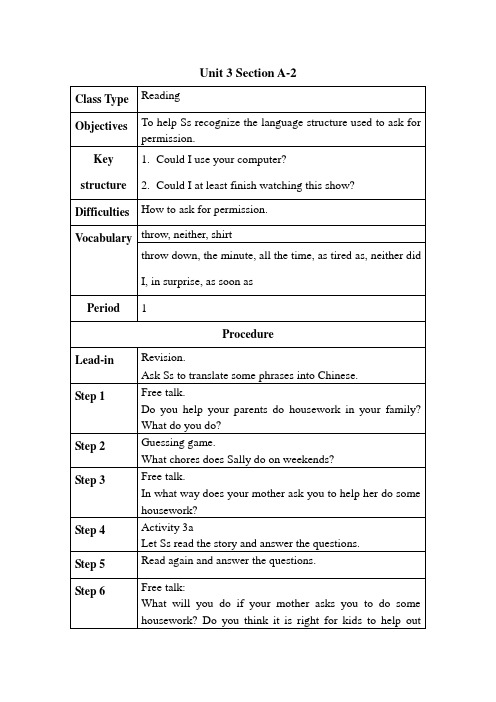
Unit 3 Section A-2Class Type ReadingObjectives To help Ss recognize the language structure used to ask for permission.Key structure 1.Could I use your computer?2.Could I at least finish watching this show?Difficulties How to ask for permission.Vocabulary throw, neither, shirtthrow down, the minute, all the time, as tired as, neither didI, in surprise, as soon asPeriod 1ProcedureLead-in Revision.Ask Ss to translate some phrases into Chinese.Step 1 Free talk.Do you help your parents do housework in your family?What do you do?Step 2 Guessing game.What chores does Sally do on weekends?Step 3 Free talk.In what way does your mother ask you to help her do somehousework?Step 4 Activity 3aLet Ss read the story and answer the questions.Step 5 Read again and answer the questions.Step 6 Free talk:What will you do if your mother asks you to do somehousework? Do you think it is right for kids to help outwith housework? Why or why not? Give your reasons. Step 7 Activity 3b.Read the sentences below. Underline the sentences from thereading that mean the same thing.Step 8 Activity 3c.Decide whether the underlined words in the sentences areverbs or nouns. Then write another sentence using theunderlined word in the other form.Step 9 Language points: explain the key words and phrases in section A-2.。
2018人教版新目标初二英语下册Unit 5 单元教案
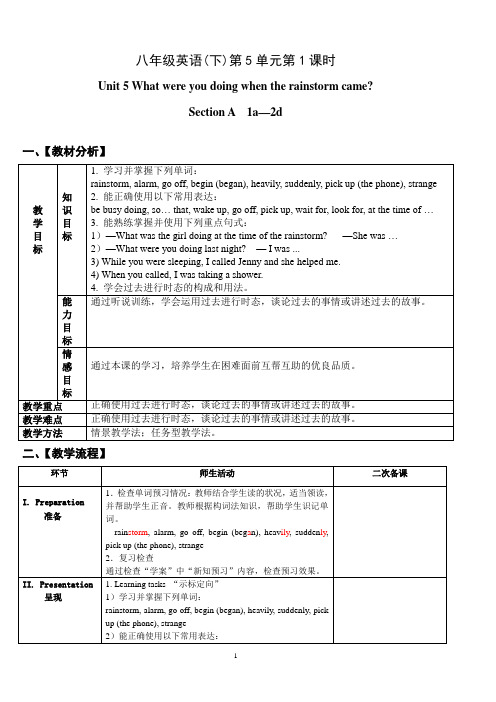
八年级英语(下)第5单元第1课时
Unit 5 What were you doing when the rainstorm came?
Section A 1a—2d
一、【教材分析】
二、【教学流程】
八年级英语(下)第5单元第2课时
Unit 5 What were you doing when the rainstorm came?
Section A 3a—3c
一、【教材分析】
二、【教学流程】
八年级英语(下)第5单元第3课时
Unit 5 What were you doing when the rainstorm came?
Section A Grammar Focus—4c
一、【教材分析】
【教学流程】
二、
八年级英语(下)第5单元第4课时
Unit 5 What were you doing when the rainstorm came?
Section B 1a—1d
一、【教材分析】
二、【教学流程】
八年级英语(下)第5单元第5课时
Unit 5 What were you doing when the rainstorm came?
Section B 2a—2e 一、【教材分析】
二、【教学流程】
八年级英语(下)第5单元第6课时
Unit 5 What were you doing when the rainstorm came?
3a—Self Check
一、【教材分析】
二、【教学流程】。
人教版八年级下册全册英语教学设计
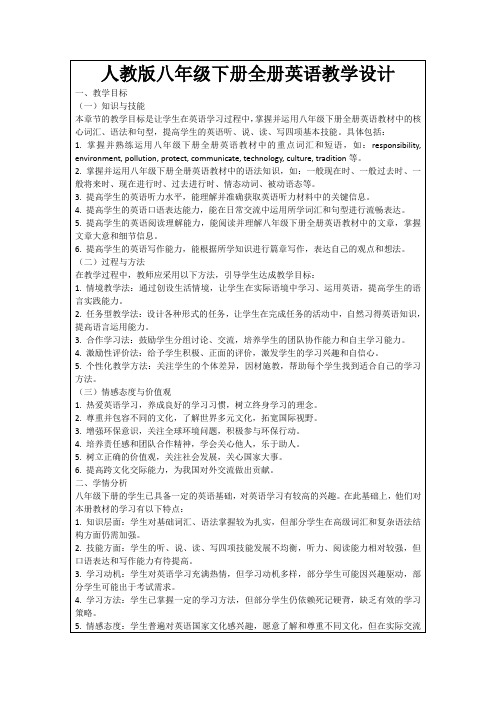
一、教学目标
(一)知识与技能
本章节的教学目标是让学生在英语学习过程中,掌握并运用八年级下册全册英语教材中的核心词汇、语法和句型,提高学生的英语听、说、读、写四项基本技能。具体包括:
1.掌握并熟练运用八年级下册全册英语教材中的重点词汇和短语,如:responsibility, environment, pollution, protect, communicate, technology, culture, tradition等。
4.学习方法:学生已掌握一定的学习方法,但部分学生仍依赖死记硬背,缺乏有效的学习策略。
5.情感态度:学生普遍对英语国家文化感兴趣,愿意了解和尊重不同文化,但在实际交流中,部分学生可能存在紧张、恐惧等情绪。
6.个性差异:学生个体差异明显,学习进度、兴趣点和优势技能各不相同。
针对以上学情,教师应结合教材内容,采取有针对性的教学方法,激发学生的学习兴趣,提高他们的英语综合运用能力。同时,关注学生的情感需求,营造轻松、愉快的学习氛围,帮助他们在英语学习中找到适合自己的发展路径。
1.知识层面:学生对基础词汇、语法掌握较为扎实,但部分学生在高级词汇和复杂语法结构方面仍需加强。
2.技能方面:学生的听、说、读、写四项技能发展不均衡,听力、阅读能力相对较强,但口语表达和写作能力有待提高。
3.学习动机:学生对英语学习充满热情,但学习动机多样,部分学生可能因兴趣驱动,部分学生可能出于考试需求。
2.教学过程:
(1)展示一组关于环境污染的图片,如:空气污染、水污染等,让学生观察并思考这些现象对我们的生活和环境造成的影响。
(2)播放一段关于环保的视频,让学生了解环保的重要性以及我们可以采取的措施。
新人教版八年级下册英语全册教案附教学反思
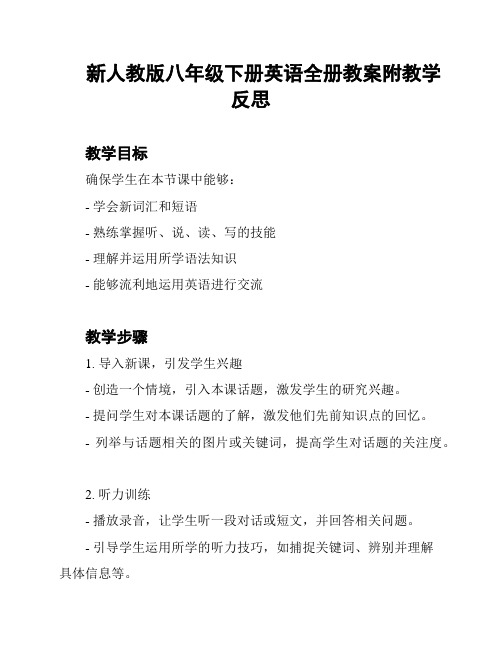
新人教版八年级下册英语全册教案附教学反思教学目标确保学生在本节课中能够:- 学会新词汇和短语- 熟练掌握听、说、读、写的技能- 理解并运用所学语法知识- 能够流利地运用英语进行交流教学步骤1. 导入新课,引发学生兴趣- 创造一个情境,引入本课话题,激发学生的研究兴趣。
- 提问学生对本课话题的了解,激发他们先前知识点的回忆。
- 列举与话题相关的图片或关键词,提高学生对话题的关注度。
2. 听力训练- 播放录音,让学生听一段对话或短文,并回答相关问题。
- 引导学生运用所学的听力技巧,如捕捉关键词、辨别并理解具体信息等。
3. 口语练- 将学生分成小组,让他们进行对话练。
- 鼓励学生使用本课所学的词汇、短语和句型进行表达,并互相交流意见。
4. 阅读理解- 给学生发放阅读材料,要求他们阅读并回答相关问题。
- 引导学生运用阅读策略,如预测、推理、寻找关键词等,提高阅读效果。
5. 写作训练- 给学生一个写作任务,如写一篇关于本节课内容的短文。
- 鼓励学生灵活运用所学语言知识,展示他们的写作技巧和逻辑思维能力。
6. 课堂总结和反思- 学生回答老师提出的问题,总结本节课的研究内容。
- 老师问学生对本节课的评价和建议,促进学生对研究的反思和提升。
教学反思本节课中,学生积极参与讨论,合作学习,表现出良好的语言运用能力。
然而,有些学生对听力训练和写作训练的难度较高,需要进一步加强练习和指导。
在下节课中,我会更注重这些方面的训练,同时鼓励学生多使用英语进行口语练习,提高语言表达能力。
此外,我还会寻找更多与学生日常生活和兴趣相关的话题,以激发他们的学习兴趣和动力。
(完整版)新版人教版八年级英语下册全册教案

新版人教版八年级英语下册全册教案Unit 1 What’s the matter?教学目标:1语言目标:描述健康问题的词汇,及如何根据别人的健康问题提建议。
2 技能目标:能听懂谈论健康问题的对话材料;能根据别人的健康问题提建议;能写出重点单词和重点句型,并能描述怎样对待健康问题。
3 情感目标:通过开展扮演病人等活动,培养学生关心他人身体健康的品质。
通过本课的阅读,培养学生处理紧急事件的基本能力,树立紧急事件时互相帮助的精神。
教学重点:短语: have a stom achache, have a cold, lie down, take one’s temperature,go to a doctor, get off, to one’s surprise, agree to do sth., get into trouble,fall down, be used to, run out (of), cut off , get out of, be in control of ,keep on (doing sth.), give up句子: 1 What’s the matter? I have a stomachache. You shouldn’t eat so much next time.2 What’s the matter with Ben?He hurt himself. He has a sore back.He should lie down and rest.3 Do you have a fever? Yes, I do. No, I don’t. I don’t know.4 Does he have a toothache? Yes, he does.He should see a dentist and get an X-ray.5 What should she do? She should take her temperature.6 Should I put some medicine on it? Yes, you should No, you shouldn’t.教学难点:掌握情态动词should \should n’t. 的用法;学习have的用法。
新人教版八年级下册英语全册教案
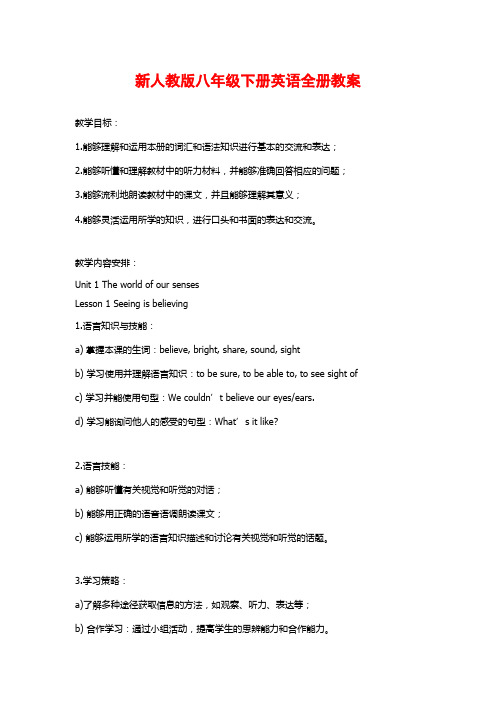
新人教版八年级下册英语全册教案教学目标:1.能够理解和运用本册的词汇和语法知识进行基本的交流和表达;2.能够听懂和理解教材中的听力材料,并能够准确回答相应的问题;3.能够流利地朗读教材中的课文,并且能够理解其意义;4.能够灵活运用所学的知识,进行口头和书面的表达和交流。
教学内容安排:Unit 1 The world of our sensesLesson 1 Seeing is believing1.语言知识与技能:a) 掌握本课的生词:believe, bright, share, sound, sightb) 学习使用并理解语言知识:to be sure, to be able to, to see sight ofc) 学习并能使用句型:We couldn’t believe our eyes/ears.d) 学习能询问他人的感受的句型:What’s it like?2.语言技能:a) 能够听懂有关视觉和听觉的对话;b) 能够用正确的语音语调朗读课文;c) 能够运用所学的语言知识描述和讨论有关视觉和听觉的话题。
3.学习策略:a)了解多种途径获取信息的方法,如观察、听力、表达等;b) 合作学习:通过小组活动,提高学生的思辨能力和合作能力。
Lesson 2 Smell and taste1.语言知识与技能:a) 掌握本课的生词:escape, experience, familiar, smooth, woolb) 学习使用并理解语言知识:to be able to, in one’s lifec) 学习并能使用句型:I can’t stand the smell/taste of…d) 学习能询问他人的感受的句型:What does it taste/smell like?2.语言技能:a) 能够听懂有关嗅觉和味觉的对话;b) 能够用正确的语音语调朗读课文;c) 能够运用所学的语言知识描述和讨论有关嗅觉和味觉的话题。
新人教版八年级英语下册教案(全册全英文)

新人教版八年级英语下册教案(全册全英文)新人教版八年级英语下册教案(全册全英文)Unit 1 Will people have robots ?Teaching goals:1.Words&phrases: robot, paper, less, fewer, simple, unpleasant, factory, seem, etc .2.will 构成的一般将来时态的陈述句、否定句、疑问句及回答.3.There be 句型的一般将来时.4.more , less , fewer 的用法.5.学习一般将来时态的相关知识,学会对未来进行预测.6.对five years ago ,today ,in five years 简洁回顾与展望的方式,贴近实际符合学生心理,激发学习兴趣.7.通过时间对比复习一般过去时态、一般现在时态,巩固一般将来时. Important and difficult points :1.will构成一般将来时态的句式。
2.There be 句型的一般将来时态。
3.more , fewer , less 的用法。
4.How to make predictions .Period 1Teaching procedures:Step 1 Leading in1.Greetings: Welcome to school .What’s the date today ? Who’s on duty today ?Do you enjoy your winter holiday ?Do you finish your homework ?Do you want to live on the moon ?Can you guess what will happen in ten years ?Collect the Ss’ ans wers and say something about theirpredictions .Step 2 Pre-taskSB Page 2 ,1a .1.Look at the picture :How will the world be different in the future ,100 years fromnow ?We’re going to talk about sth in 100 years .2.Read each predictions to the class .Explain the new vocabulary .3.Read the instructions .Make sure Ss know what they should do .4.Do it by themselves .5.Talk about the answers with the class .Explain :一般将来时态构成: will / be going to +动词原形Step 3 While-taskSB Page 2 ,1b .1.Practise reading the six predictions .2.Read the instructions to Ss .Circle the things you hear on the recording .3.Play the tape twice .4.Play the tape a third time .At the same time ,check the answers .SB Page 2 , 1c .1.Pay attention to the dialogues .2.Read the dialogues fluently .3.Pairwork .Work in pairs to make predictions according to the sample .4.Ask several pairs to share their conversations to the class .SB Page 3 , 2a & 2b .1.Read the predictions .2.Read the instructions and point out the sample answer .3.Play the tape twice .Ss circle the word they hear in each sentences: more , less ,fewer .4.Check the answers .学生探究: less , fewer 的区别。
2018-2019学年人教新目标版八年级英语下册全册教案
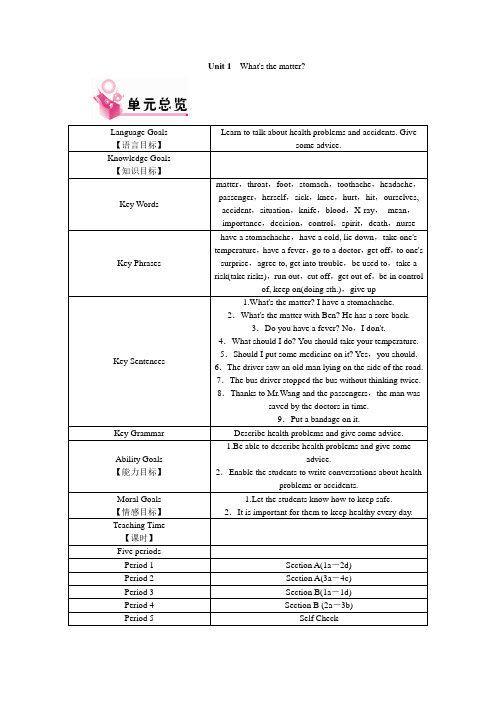
Unit 1What's the matter?Language Goals 【语言目标】Learn to talk about health problems and accidents. Givesome advice.Knowledge Goals 【知识目标】Key Words matter,throat,foot,stomach,toothache,headache,passenger,herself,sick,knee,hurt,hit,ourselves, accident,situation,knife,blood,X-ray,mean,importance,decision,control,spirit,death,nurseKey Phraseshave a stomachache,have a cold, lie down,take one's temperature,have a fever,go to a doctor,get off,to one's surprise,agree to, get into trouble,be used to,take a risk(take risks),run out,cut off,get out of,be in control of, keep on(doing sth.),give upKey Sentences1.What's the matter? I have a stomachache.2.What's the matter with Ben? He has a sore back.3.Do you have a fever? No,I don't. 4.What should I do? You should take your temperature. 5.Should I put some medicine on it? Yes,you should. 6.The driver saw an old man lying on the side of the road. 7.The bus driver stopped the bus without thinking twice. 8.Thanks to Mr.Wang and the passengers,the man wassaved by the doctors in time.9.Put a bandage on it.Key Grammar Describe health problems and give some advice.Ability Goals 【能力目标】1.Be able to describe health problems and give someadvice.2.Enable the students to write conversations about healthproblems or accidents.Moral Goals 【情感目标】1.Let the students know how to keep safe. 2.It is important for them to keep healthy every day.Teaching Time【课时】Five periodsPeriod 1 Section A(1a-2d) Period 2 Section A(3a-4c) Period 3 Section B(1a-1d) Period 4 Section B (2a-3b) Period 5 Self Check本单元教材以“What's the matter?”为中心话题,围绕着询问及描述“身体状况”进行学习和运用几个常见的句型:What's the matter? I have a stomachache./What's the matter with Ben? He has a sore back./Do you have a fever?No,I don't./What should I do? You should take your temperature./ Should I put some medicine on it? Yes,you should.等。
- 1、下载文档前请自行甄别文档内容的完整性,平台不提供额外的编辑、内容补充、找答案等附加服务。
- 2、"仅部分预览"的文档,不可在线预览部分如存在完整性等问题,可反馈申请退款(可完整预览的文档不适用该条件!)。
- 3、如文档侵犯您的权益,请联系客服反馈,我们会尽快为您处理(人工客服工作时间:9:00-18:30)。
He should see a dentist and get an X-ray.
5 What should she do? She should take her temperature.
6 Should I put some medicine on it? Yes, you should No, you shouldn’t.
八年级下册英语教案
马街二中
Unit 1 What’s the matter?
教学目标:
1语言目标:描述健康问题的词汇,及如何根据别人的健康问题提建议。
2 技能目标:能听懂谈论健康问题的对话材料;能根据别人的健康问题提建议;能写出重点单词和重点句型,并能描述怎样对待健康问题。
3 情感目标:通过开展扮演病人等活动,培养学生关心他人身体健康的品质。
B:She didn’t take care of herself on the weekend. She was playing with her friends at the park yesterday. Then it got windy, but she didn’t put on her jacket. Now she has a cold.
教学难点:掌握情态动词should \shouldn’t. 的用法;学习have的用法。
课时划分:3a-3c
Section A3 Grammar Focus-4c
Section B1 1a-2e
Section B2 3a-Self check
Boy: I _________________.
Conversation 3
Nurse: What’s the matter, Ben?
Boy: I _________________.
Conversation 4
Nurse: What’s the matter, Nancy?
Girl: I _________________.
Section A 1 (1a – 2d)
Step 1 Warming up and new words
1.Look at a picture and learn the parts of the body.
2.New words and phrases.
Step 2 Presentation
1a Look at the picture. Write the correct letter [a-m] for each part of the body.
2 What’s the matter with Ben?
He hurt himself. He has a sore back.
He should lie down and rest.
3 Do you have a fever? Yes, I do. No, I don’t. I don’t know.
Examples
A: What’s the matter with Judy?
B: She talked too much yesterday and didn’t drink enough water.
She has a very sore throat now.
A: What’s the matter with Sarah?
Step 5 Guessing games
Guess what has happened to the students by using the important sentences.
Step 6 Listening
2a Listen and number the pictures [1-5] in the order you hear them.
Listen to the conversations again and fill in the blanks.
Conversation 1
Nurse: What’s the matter, Sarah?
Girl: I ___________.
Conversation 2
Nurse: What’s the matter, David?
fall down, be used to, run out (of), cut off , get out of, be in control of ,
keep on (doing sth.), give up
句子: 1What’s the matter? I have a stomachache. You shouldn’t eat so much next time.
___arm ___ back ___ ear ___ eye ___ foot
___hand ___ head ___ leg ___ mouth
___ neck ___nose ___ stomach ___ tooth
Step 3 Listening
1b Listen and look at the picture. Then number the names 1-5
通过本课的阅读,培养学生处理紧急事件的基本能力,树立紧急事件时互相帮助的精神。
教学重点:
短语: have a stomachache, have a cold, lie down, take one’s temperature,
go to a doctor, get off, to one’s surprise, agree to do sth., get into trouble,
Conversation 5
Betty: What’s the matter, Judy?
Ann: She __________________.
Step 4 Speaking
1c Look at the pictures. What are the students’ problems? Make conversations.
2b Listen again. Match the problems with the advice.
